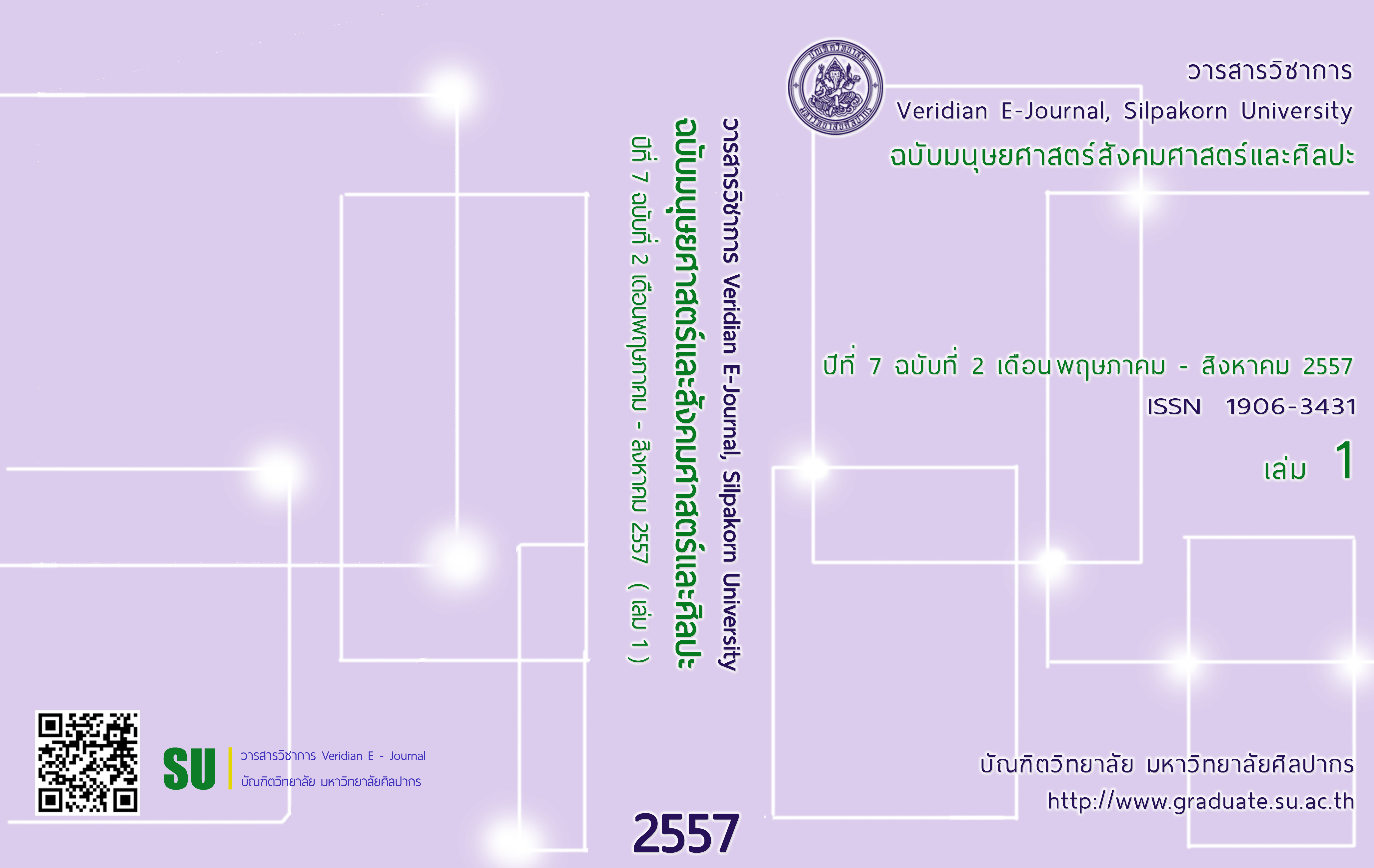การพัฒนาแบบฝึกทักษะการอ่านวรรณกรรมภาษาอังกฤษด้วยวงจรวรรณกรรมเพื่อส่งเสริมความสามารถในการอ่านอย่างมีวิจารณญาณสำหรับนักเรียนชั้นมัธยมศึกษาปีที่ 4 โรงเรียนสาธิต มหาวิทยาลัยศิลปากร
Main Article Content
Abstract
บทคัดย่อ
การวิจัยครั้งนี้มีจุดประสงค์เพื่อ 1) พัฒนาและหาประสิทธิภาพของแบบฝึกทักษะการอ่านอย่างมีวิจารณญาณด้วยวงจรวรรณกรรม 2) เปรียบเทียบความสามารถในการอ่านอย่างมีวิจารณญาณของนักเรียนก่อนและหลังการใช้แบบฝึกทักษะการอ่าน และ3) ศึกษาความคิดเห็นของนักเรียนที่มีต่อแบบฝึกทักษะการอ่าน ซึ่งกลุ่มตัวอย่าง คือ นักเรียนชั้นมัธยมศึกษาปีที่ 4 สายวิทยาศาสตร์-คณิตศาสตร์ โรงเรียนสาธิต มหาวิทยาลัยศิลปากร จำนวน 30 คน ที่เรียนรายวิชาภาษาอังกฤษอ่าน-เขียน ในภาคการศึกษาที่ 2 ปีการศึกษา 2555 โดยได้มาจากการสุ่มห้องเรียน ด้วยการสุ่มอย่างง่าย ผู้วิจัยทำการทดลองโดยให้นักเรียนเรียนด้วยแบบฝึกฯ จำนวน 3 บท ใช้เวลาในการเรียน 15 สัปดาห์ สัปดาห์ละ 1 คาบเรียน คาบเรียนละ 50 นาที เครื่องมือที่ใช้ในการวิจัยประกอบด้วย 1) แบบฝึกเสริมทักษะการอ่านแบบฝึกทักษะการอ่านอย่างมีวิจารณญาณด้วยวงจรวรรณกรรม 2) แบบทดสอบวัดความสามารถในการอ่านอย่างมีวิจารณญาณก่อนและหลังการใช้แบบฝึกทักษะการอ่าน และ 3) แบบสอบถามความคิดเห็นต่อแบบฝึกทักษะการอ่าน ผู้วิจัยทำการวิเคราะห์ข้อมูลด้วยค่าสถิติที เพื่อเปรียบเทียบความสามารถในการอ่านอย่างมีวิจารญาณของนักเรียนก่อนและหลังเรียนด้วยแบบฝึกฯ และใช้ค่าเฉลี่ย ส่วนเบี่ยงเบนมาตรฐานในการหาค่าระดับความคิดเห็นของนักเรียนที่มีต่อแบบฝึกทักษะการอ่าน ผลการวิจัยพบว่า 1) ประสิทธิภาพของแบบฝึกฯ มีค่าเท่ากับ 80.02/80.93 สูงกว่าที่กำหนดไว้คือ 75/75 2) ความสามารถในการอ่านอย่างมีวิจารณญาณของนักเรียนสูงขึ้นหลังเรียนด้วยแบบฝึกทักษะการอ่าน อย่างมีนัยสำคัญที่ระดับ 0.05 และ 3) นักเรียนมีความคิดเห็นที่ดีต่อแบบฝึกทักษะการอ่านที่ผู้วิจัยสร้างขึ้น
คำสำคัญ : แบบฝึกทักษะ/การอ่านอย่างมีวิจารณญาณ/วรรณกรรม/วงจรวรรณกรรม
Abstract
The purposes of this research were to: 1) develop and test the efficiency of the English Literature Reading Exercises by using Literature Circles to enhance critical reading ability for Mathayom four students of the Demonstration School, Faculty of Education, Silpakorn University 2) compare the students’ ability in critical reading skill before and after using the exercises; and 3) survey the students’ opinions toward the exercises The sample, selected by a simple random sampling, comprised 30 Mathayom-four students in Math-science program of the Demonstration School, Faculty of Education, Silpakorn University who registered in English Reading and Writing course during the second semester of the academic year 2012. The students studied the exercises through 3 units in a fifteen-week period by using these research instruments: 1) the English Literature Critical Reading Exercises; 2) an English achievement test on critical reading, used as a pretest-posttest; and 3) a questionnaire. To analyze the gathered data, the paired-sample t-test was used in order to assess the students’ ability in critical reading skill before using the exercises. Furthermore, the mean and the standard derivation of items were used to evaluate the students’ opinions towards the exercises. The results of the study were as follows: 1) The efficiency score of the English Literature Critical Reading Exercises was 80.02/80.93. It is higher than the expected criterion (75/75) 2) The students’ ability in critical reading after studying through the exercises was significantly higher at 0.05 level. 3) The students’ opinions toward the exercises were highly positive.
KEY WORDS : READING EXERCISE/ CRITICAL READING/ LITERATURE/ LITERATURE CIRCLES
